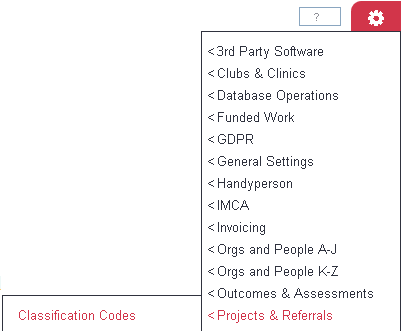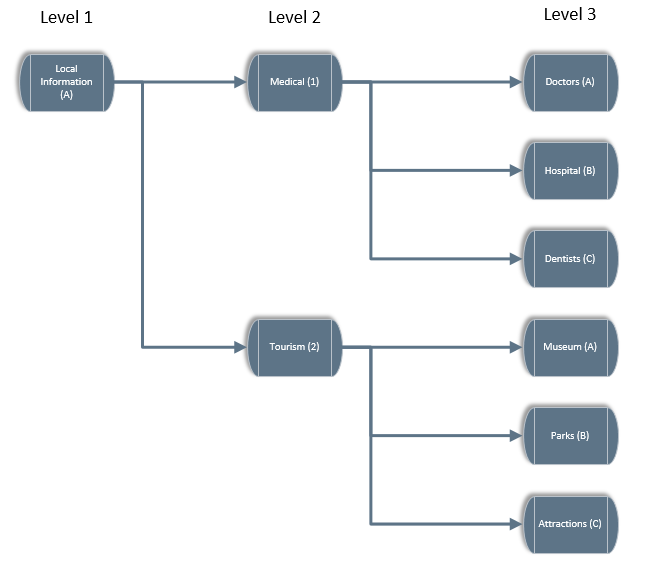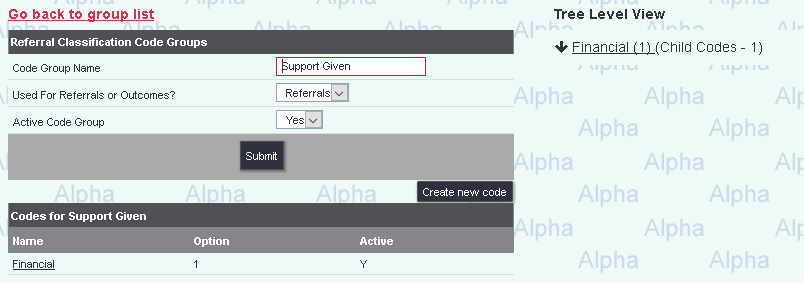Classification Code Setup
Contents
Introduction
Classification Codes are a flexible tiered coding system that can be used to report on various different statistics:
- Presented Issues
- Support Provided
- Information Given
- Leaflets
- Outcomes
The codes are in a levels (tiers) to offer a simple yet effective method of monitoring. Level 2 is a subcategory/breakdown of level 1, level 3 is a subcategory of level 2 and so on. You can either a single level or multiple levels. There is no limit to the number of levels, however the on screen report will only show the first three levels, excel extract will include all levels.
Looking at the diagram below, if information about Dentists was given then this would be a code of A1C, Local Information (A)/Medical(1)/Dentists(C).
Classification codes can be used either on the Record A Contact screen (as well as the history tab) or on the referral closure page as outcome codes, this is specified on the codes tab per project setup. Each project can also use multiple groups of codes, so you could use Presented Issues, Support Given and Outcomes.
Creating or Editing code groups
To edit the name or type of an existing group click on its name. To create a new group click on the 'Create New Code Group' button, you will then be taken to the group edit screen including level one codes.
In the top section of the screen you will be displayed the fields for the Code Group.
- Code Group Name - The name of the group/collection of codes.
- Used For Referrals or Outcomes? - Specify if the group is to be used on the Record A Contact screen or on the referral closure page.
- Active Code Group? - If active then the group can be used with projects.
Click on 'submit' to save any changes, you will remain on the page so that you can create the top level codes of the group (level 1).
At the top of the page you will be presented a link to return to the list of existing groups. If you have already created codes in the top level they will be display in the lowers section where they can be managed. In the right you will find a tree view to show the structure of the code group. The tree view can be used to navigate around the code structure.
Editing/Adding codes Codes (including questions and sub-codes
Click on the name of the code to wish to:
- Edit
- Add question for the user to complete when the code is selected
- Create sub codes
You will File:CC tier2example.PNG
The above example show that we are in a code group called 'Support Given' and we are in the sub options (tier 2) for the Tier 1 code 'Financial'. To edit any existing codes click on the name of the code or click the 'Create New Tier 2 Code' button to create a new option. From here we can then navigate to the next tier, adding sub options for each code on tier 2. To return to the previous tier we would simply click on the codes options name in the title. Tier 3 onwards would be managed and navigated just like tier 2.
Creating and Editing Code options
If your are on tier one this will be displayed at the top, otherwise you will be displayed the name of the option you are adding a sub code to. To edit an existing code option click on the name or use the 'Create new option' button to create a new code. Enter/edit the following:
- Code Letter/Number (for this option) - The system will auto populate the next available code for the tier that you are on. Tier 1 is alphabetical, tier 2 is numeric, tier 3 is alphabetical and so on. You can change the suggested code however you need to ensure that is has not been used previously.
- Code Name (Name of the option) - This is the displayed name of the code.
- Active? - When set to yes this option is available.
Click on the 'Save Details' button to save the changes and to return to the tier that you were on. Alternatively yo can click the 'Save and Enter Questions' button to save the changes and create a question that will appear when the code is entered.
Creating and Editing Questions
Questions are used to collect additional information when a code has been selected. You can have multiple question per code. When creating questions you will be displayed what code you are creating questions for (see the image below). To edit an exiting an existing question click on the name or click the 'Enter New Question' to create a new one. Complete the following:
- Question Text - This is the displayed question.
- Help Text - Displayed for the administrator on this page only.
- Question Type - Select the type of question required:
- Date - Date box will be displayed.
- Decimal - Displays a numeric box with two decimal places.
- Numeric - Displays a numeric box with no decimal places.
- Select List - Creates a drop down list for the user to select from. When saving you will then be asked for the options in the list. Use the red links to navigate back to the list of questions.
- Text - Creates a small text box to enter information in.
- Active - When set to yes this question will be displayed when the code is selected.
Display Full Structure
You can produce a list of codes on the Code Groups page by clicking the 'Display Full Structure' button. You will then be displayed a list of all the active codes.
Using Codes
Once the code group and codes have been setup they need to be enabled in each project that requires them. Please see Project Set Up for details. Below is an example of how the codes will appear to the user:




